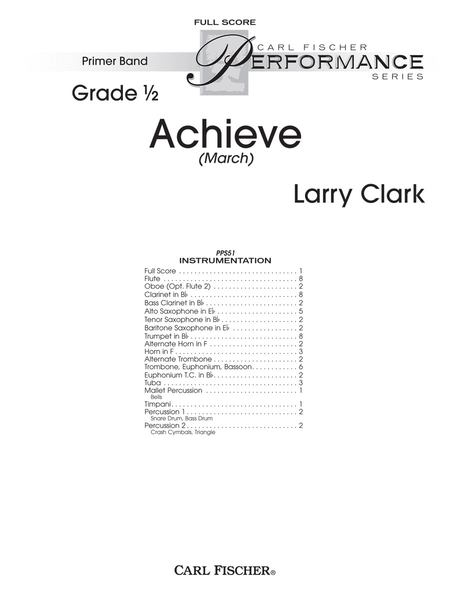Achieve
March
-
Ships in 1 to 2 weeks
Details
Description
SKU: CF.PPS51F
March. Composed by Larry Clark. Primer Band (PPS). Full score. With Standard notation. 12 pages. Carl Fischer Music #PPS51F. Published by Carl Fischer Music (CF.PPS51F).ISBN 9781491152638. UPC: 680160910137.
The march style is important to the heritage of the modern concert band. Why not get beginners off to a great start by teaching them this essential band style as early as possible? Achieve uses only the first six notes of the Bb-major scale and utilizes two repeated eighth notes as the most difficult rhythm. It is written in traditional march form and style, but without modulation in the trio.
The march style is important to the heritage of the modern concert band, and it is my opinion that even the youngest of students should be taught the march style and form as early as possible. This march sets out to give these students that opportunity. It uses only the first six notes of the Bb-major scale, and the most difficult rhythm is two repeated eighth notes. Yet it has all of the traditional march form and style. The form of this easy march is the traditional intro, first strain, second strain and trio. The only difference from more challenge marches is that the key does not change to the subdominant at the trio. Most everything else is the same as you would find in the American marches of Sousa, Fillmore or King.The march begins forte with a quote from the end of the second strain, something that is common in many marches. This is followed by the first strain at a softer dynamic level. Additional voices are added on the repeat for variety. The second strain has tradition changes in dynamics, first starting out loud, then getting soft with crescendos to the end of the strain. The trio following again in typical fashion with the first time being very soft and legato. There are some suggestions for changing the orchestration, but you can use your creativity to tailor the instrumentation to your musical taste. The repeat of the trio should then be back to a more marcato march style. This should start with the last note of the first ending in m. 70. The march then ends with the traditional stinger.It is my opinion that in marches with this form that the repeats should not be eliminated. By doing so, it changes the form and makes the march lopsided, with the first half of the marching being too short compared to the trio section.It has been my pleasure to have the opportunity to write this piece. I hope you and your students enjoy it and find it useful for your program.—Larry ClarkLakeland, FL 2018.

 Share
Share